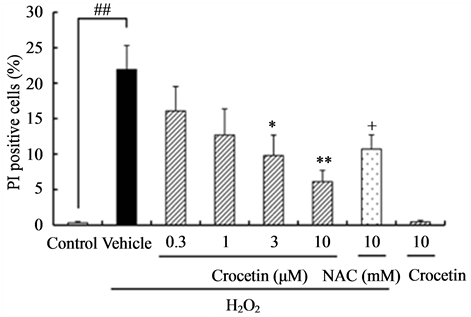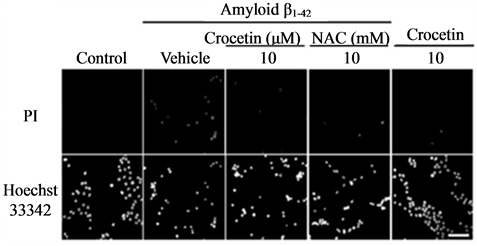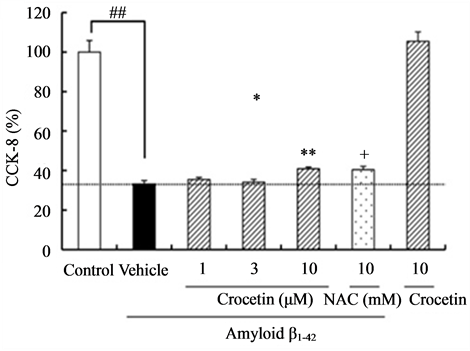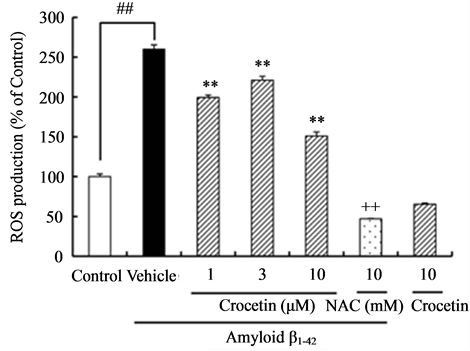Pharmacology & Pharmacy
Vol.5 No.1(2014), Article ID:41886,6 pages DOI:10.4236/pp.2014.51007
Crocetin Prevents Amyloid β1-42-Induced Cell Death in Murine Hippocampal Cells
![]()
1Molecular Pharmacology, Department of Biofunctional Evaluation, Gifu Pharmaceutical University, Gifu, Japan; 2Riken Vitamin Co., Ltd., Tokyo, Japan.
Email: *hidehara@gifu-pu.ac.jp
Received November 14th, 2013; revised December 19th, 2013; accepted December 30th, 2013
ABSTRACT
Crocetin is an aglycon of carotenoid extracted by saffron stigmas (Crocus sativus L.) and known to have a potent anti-oxidative effect. Amyliod β (Aβ), hallmark of Alzheimer’s disease, is reported to have neurotoxicity partly via oxidative stress. In this study, we investigated the effect of crocetin on hippocampal HT22 cell death induced by Aβ1-42. Furthermore, to clarify the mechanism underlying the protective effects of crocetin against Aβ1-42- induced cell death, we measured reactive oxygen species (ROS) production by CM-H2DCFDA kit assay. Crocetin at 1 - 10 μM protected HT22 cells against Aβ1-42-induced neuronal cell death and decreased ROS production increased by Aβ1-42. These results that crocetin has the potent neuroprotective effect against Aβ1-42-induced cytotoxicity in hippocampal cells by attenuating oxidative stress, suggest that crocetin may provide a useful therapeutic strategy against Aβ-related disorders.
Keywords:Alzheimer’s Disease; Amyloid β1-42; Crocetin; HT22; Oxidative Stress
1. Introduction
Alzheimer’s disease (AD) is a common neurodegenerative disorder, and amyloid β (Aβ) has been considered to have a critical role in the pathogenesis of AD [1]. AD is characterized by cognitive dysfunction and neuronal loss and these changes had been reported to occur as the result of various events, such as oxidative stress, neuroinflammation, and cholinergic deficits [2-4]. It is well known that the oxidative stress is involved in the mechanism of Aβ-induced neurotoxicity [5].
Crocetin, the aglycone of crocin carotenoids, is found in the saffron stigmas (Crocus sativus L.) and gardenia fruit (Gardenia jasminoides Ellis) [6,7] and they had been used for treatment of some diseases as traditional medicine [8]. Furthermore, crocetin has various pharmacological effects, such as anti-cancer [9], hepatoprotective [10], anti-oxidative [11], anti-inflammatory [8], and neuroprotective effects [12]. Crocetin has been reported to inhibit Aβ fibrillization and stabilize Aβ oligomers [13]. We recently reported that crocetin prevents retinal damage induced by H2O2, tunicamycin, and N-methyl-Daspartate (NMDA) [14,15]; saffron extracts have been reported to be effective on memory deficit on mild AD patient [16,17]. However, there was no report on protective effects of crocetin in hippocampal neuronal cells having been examined.
In the present study, therefore, we investigated the effects of crocetin against Aβ1-42-induced cell death in HT22 mouse derived hippocampal cells.
2. Material and Methods
2.1. Materials
Aβ1-42 peptide (Abcam, Cambridge, UK) was dissolved in dimethyl sulfoxide (DMSO), then diluted in phosphate buffered saline (PBS; pH 7.4) according to manufacturer’s data sheets. Oligomers/fibrils of Aβ1-42 was achieved by incubation of 2 mM stock solution at 37˚C for 2 h. Crocetin was obtained from Riken Vitamin Co., Ltd. (Tokyo, Japan).
2.2. Cell Cultures
Mouse hippocampal HT22 cells were gifted by Yoko Hirata Ph.D. (Gifu University, Japan). Cells were maintained in Dulbecco’s modified Eagle’s medium (D-MEM; Nacalai tesque, Kyoto, Japan) containing 10% fetal bovine serum (FBS), 100 units/mL penicillin (Meiji Seika Kaisha Ltd., Tokyo, Japan), and 100 μg/mL streptomycin (Meiji Seika) in a humidified atmosphere of 95% air and 5% CO2 at 37˚C. Cells were passaged by trypsinization every 2 or 3 days, and maintained in a 10 cm dish (BD Biosciences, Franklin Lakes, NJ, USA).
2.3. Cell Death Assay
HT22 cells were seeded at 1 × 103 cells per well into 96-well plates (BD Biosciences), then incubated for 24 h at 37˚C in a humidified atmosphere of 95% air and 5% CO2. The entire medium was then replaced with fresh medium containing 1% FBS. Then, 2 μM of Aβ, with or without 0.1 - 10 μM of crocetin, and N-acetyl-L-cysteine (NAC; Wako, Osaka, Japan) were added and incubated for 48 h at 37˚C. NAC, which is well known to have a potent anti-oxidant effect, was used as a positive control in this study. Crocetin and NAC were dissolved in PBS containing 1% DMSO. After 46 h incubation, the medium was replaced with fresh medium containing 1% FBS, then the cells viability was measured by using CCK-8 kit (Dojindo, Kumamoto, Japan).
Nuclear staining assays were carried out after 48 h incubation. Cell death was assessed by combination staining with Hoechst 33342 (Molecular Probes, Eugene, OR) and propidium iodide (PI; Molecular Probes). Images were collected by using an inverted epifluorescence microscope (IX70; Olympus. Co., Tokyo, Japan). The number of cells per condition was counted in a blind manner by a single observer (Y.Y.) with the aid of imageprocessing software (Image-J, version 1.33f; National Institutes of Health, Bethesda, MD, USA).
In the investigation of H2O2 stress, HT22 cells were seeded at 3 × 103 cells per well. The entire medium was replaced with fresh medium containing 1% FBS after 24 h incubating. H2O2 were added 1 h after pretreatment with or without 0.1 - 10 μM of crocetin, and NAC. Then, nuclear staining assays were carried out after 24 h incubition.
2.4. CM-H2DCFDA Kit Assay
The end of the culture period, HT22 cells were exposed to 10
![]() μM 5-(and-6)-chloromethyl-2’, 7’-dichlorodihydrofluorescein diacetate, acetyl ester (CM-H2DCFDA) (Invitrogen Life Technologies, Carlsbad, CA, USA) for 1 h. Fluorescence was measured by using a Varioskan flash 2.4 microplate reader (Thermo Fisher Scientific, Waltham, MA, USA) at the excitation/emission wavelengths of 485/535 nm. The levels of reactive oxygen species (ROS) were calculated as percent increases compared with the control, and the control was normalized to 100% of the basal level.
μM 5-(and-6)-chloromethyl-2’, 7’-dichlorodihydrofluorescein diacetate, acetyl ester (CM-H2DCFDA) (Invitrogen Life Technologies, Carlsbad, CA, USA) for 1 h. Fluorescence was measured by using a Varioskan flash 2.4 microplate reader (Thermo Fisher Scientific, Waltham, MA, USA) at the excitation/emission wavelengths of 485/535 nm. The levels of reactive oxygen species (ROS) were calculated as percent increases compared with the control, and the control was normalized to 100% of the basal level.
2.5. Statistical Analyses
Data were presented as means ± S.E.M. Statistical comparisons were made using a two-tailed t-test or one-way ANOVA followed by Dunnett’s test, P < 0.05 being considered to indicate a statistical significance.
3. Result
3.1. Crocetin Protects HT22 Cells against H2O2-Induced Cell Death
At first, we evaluated the effect of crocetin against H2O2- induced cell death by using combination staining with Hoechst 33342 (indication of alive and dead cells) and PI (indication of dead cells) (Figure 1(b)). Compared with the control group, H2O2 (200 μM) significantly increased the percentage of dead cells. Treatment with crocetin at 3 μM protected HT22 cells against H2O2-induced cell death in a concentration-dependent manner (Figure 1(c)).
3.2. Crocetin Protects HT22 Cells against Aβ1-42-Induced Cell Death
Next, we evaluated the effect of crocetin against Aβ1-42- induced cell death by using nuclear staining (Figure 2(a)). Aβ1-42 treatment at 0.2 to 20 μM induced neuronal cell death in a concentration-dependent manner (data not shown). Compared with the control group, Aβ1-42 at 2 μM significantly increased the percentage of dead cells. Treatment with crocetin at 1 to 10 μM protected HT22 cells against Aβ1-42-induced cell death (Figure 2(b)).
We also evaluated the effect of crocetin on cell viability on HT22 cells, by using CCK-8. Compared with vehicle control, Aβ1-42 at 2 μM significantly decreased the cell viability rate. Treatment with crocetin at 10 μM significantly reversed HT22 cells against Aβ1-42-induced decrease cell viability (Figure 2(c)).
3.3. Effect of Crocetin for ROS Production of HT22 Cells at Aβ1-42-Induced Cell Death
To clarify the mechanism underlying the protective effects of crocetin against Aβ1-42 (2 μM)-induced cell death,
 (a)
(a) (b)
(b) (c)
(c)
Figure 1. Crocetin protects HT22 cells against H2O2-induced cell death. (a) The chemical structure of crocetin. (b) Representative fluorescence micrographs of Hoechst 33342 (blue) and propidium iodide (PI: red) in HT22 cells. Cells were treated with vehicle, with or without crocetin, followed by H2O2 (200 μM) or vehicle for 24 h. (c) The number of Hoechst 33342 or proridium iodide (PI) positive cells were counted, and the cell death rate was expressed as the percentage of PI-positive cells to Hoechst 33342-positive cells. ##P < 0.01 versus control (Student’s t-test). *P < 0.05; **P < 0.01 versus vehicle (Dunnett’s test). ++P < 0.01 versus vehicle (Student’s t-test). Each column and bar represent mean ± S.E.M. (n = 6). Scale bar shows 100 μm.
we investigated the ROS production by CM-H2DCFDA kit assay. Treatment with Aβ1-42 at 2 μM significantly increased the ROS production, whereas treatment with crocetin at 1 to 10 μM decreased the ROS production induced by Aβ1-42 (Figure 3). NAC at 10 mM was used as a positive control, and reduced the Aβ1-42-induced increase in ROS by about 80%.
4. Discussion
In the present study, we investigated the neuroprotective effects of crocetin against Aβ1-42-induced neurotoxicity in
 (a)
(a) (b)
(b) (c)
(c)
Figure 2. Crocetin protects HT22 cells against Aβ1-42-induced cell death. (a) Representative fluorescence micrographs of Hoechst 33342 (blue) and propidium iodide (PI: red) in HT22 cells. Cells were treated with vehicle, with or without crocetin, followed by Aβ1-42 (2 μM) or vehicle for 48 h. (b) The number of Hoechst 33342 or PI positive cells were counted, and the cell death rate was expressed as the percentage of PI-positive cells to Hoechst 33342-positive cells. (c) Cell viability was measured by Cell Counting Kit-8 (CCK-8) assay, with absorbance recorded at 492 nm. ##P < 0.01 versus control (Student’s t-test). *P < 0.05; **P < 0.01 versus vehicle (Dunnett’s test). +P < 0.05; ++P < 0.01 versus vehicle (Student’s t-test). Each column and bar represent mean ± S.E.M. (n = 6). Scale bar shows 100 μm.

Figure 3. Effect of crocetin for ROS production of HT22 cells at Aβ1-42-induced cell death. ROS production was measured by CM-H2DCFDA kit assay at 48 h. Cells were presented with vehicle, with or without crocetin, followed by Aβ (2 μM) or vehicle for 48 h. ##P < 0.01 versus control (Student’s t-test). *P < 0.05; **P < 0.01 versus vehicle (Dunnett’s test). ++P < 0.01 versus vehicle (Student’s t-test). Each column and bar represent mean ± S.E.M. (n = 6).
murine HT22 hippocampal cells. Addition of Aβ1-42 peptide to HT22 cells induced cell death as well as a previous report [18]. Crocetin has been known to have potent anti-oxidant [19], anti-cancer [9], and anti-inflammation activities [8]. A number of researches show that oxidative stress involves in AD pathogenesis [20]. Hence, crocetin, a potent antioxidant, is considered to have potential of therapy for AD pathogenesis. As we predicted, crocetin showed neuroprotective effects against H2O2- and Aβ1-42-induced neuronal cell death.
Furthermore, crocetin at concentrations of 1 to 10 μM showed significantly the protective effect against Aβ1-42- induced neurotoxicity. In rat, crocetin distributed in plasma at 0.14 mM and in brain at about 40 μM by oral administration of crocetin (at a dose of 100 mg/kg) and reduced oxidative stress in brain [19]. In our previous paper, the mean peak of serum concentration of crocetin was 0.2 µg/ml (about 0.6 mM: calculated by the body weight) when healthy volunteers were administrated crocetin at a single oral dose 15 mg [21].
As we used in this study, crocetin showed a neuroprotective effect at 1 to 10 μM which is lower than that in the brain in vivo. These results suggest that crocetin may have the effect against Aβ1-42-induced neuronal cell death in the concentrations distributed in human blood.
Free radical and oxidative stress-induced neuronal cell death has been implicated in various neurological disorders, such as Perkinson’s desease and AD [22,23]. The AD-assosiated Aβ accumulating in central nerve system (CNS) plaques of AD patients’ brains induces the generation of oxygen-free radicals [24]. Hippocampal physiological function relates to memory formation and cognition system [25]. Neuronal cell death on hippocampus occurs in AD patient, and this results in cognitive dysfunction [26]. As the hippocampus is a major target for a neuronal degeneration in the brains of patients with AD, HT22 hippocampal neuronal cells used in the present study were useful.
As the mechanism underlying protective effect of crocetin, oxidative stress by ROS is considered the main pathway. A number of researches tend them attention to oxidative stress. However, the other mechanisms had been reported in partly. In previous reports, the protective effects of crocetin against various stresses in retina related to inhibition activity for caspase-3 and caspase-9 [14,15]. These results suggest that crocetin also inhibits caspase-3 and caspase-9 expression to protect the brain against cells apoptosis.
Crocetin or crocin (crocetin di-gentiobiose ester) has been reported to have the protective effects against various cognitive impairment models induced by ethanol, streptzotcin, scopolamine, aging, captured stress, or brain ischemia in vivo [27-31]. Taken together, these findings suggest that crocetin may be useful to prevent AD.
In conclusion, the present findings indicate that crocetin has neuroprotective properties against Aβ1-42-induced cytotoxicity in murine HT22 hippocampal neuronal cells, by attenuating oxidative stress.
REFERENCES
- L. Buee, D. Blum, S. Bombois, V. Buee-Scherrer, M. L. Caillet-Boudin, M. Colin, V. Deramecourt, C. M. Dhaenens, M. C. Galas, M. Hamdane, S. Humez, C. A. Maurage, F. Pasquier, B. Sablonniere, S. Schraen-Maschke and N. Sergeant, “Molecular Actors in Alzheimer’s Disease: Which Diagnostic and Therapeutic Consequences?” Therapie, Vol. 65, No. 5, 2010, pp. 401-407.
- A. Arikanoglu, E. Akil, S. Varol, Y. Yucel, H. Yuksel, M. U. Cevik, Y. Palanci and F. Unan, “Relationship of Cognitive Performance with Prolidase and Oxidative Stress in Alzheimer Disease,” Neurological Sciences, Vol. 34, No. 12, 2013, pp. 2117-2121.
- J. C. Breitner, “Inflammatory Processes and Antiinflammatory Drugs in Alzheimer’s Disease: A Current Appraisal,” Neurobiology of Aging, Vol. 17, No. 5, 1996, pp. 789-794. http://dx.doi.org/10.1016/0197-4580(96)00109-1
- K. Blennow, M. J. de Leon and H. Zetterberg, “Alzheimer’s Disease,” Lancet, Vol. 368, No. 9533, 2006, pp. 387-403. http://dx.doi.org/10.1016/S0140-6736(06)69113-7
- D. A. Butterfield, A. Castegna, C. M. Lauderback and J. Drake, “Evidence That Amyloid Beta-Peptide-Induced Lipid Peroxidation and Its Sequelae in Alzheimer’s Disease Brain Contribute to Neuronal Death,” Neurobiology of Aging, Vol. 23, No. 5, 2002, pp. 655-664. http://dx.doi.org/10.1016/S0197-4580(01)00340-2
- H. Aoki, N. Kuze, T. Ichi and T. Koda, “Analytical Method for Buddleja Colorants in Foods,” Shokuhin Eiseigaku Zasshi, Vol. 42, No. 2, 2001, pp. 84-90. http://dx.doi.org/10.3358/shokueishi.42.84
- N. Li, G. Lin, Y. W. Kwan and Z. D. Min, “Simultaneous Quantification of Five Major Biologically Active Ingredients of Saffron by High-Performance Liquid Chromatography,” Journal of Chromatography A, Vol. 849, No. 2, 1999, pp. 349-355. http://dx.doi.org/10.1016/S0021-9673(99)00600-7
- H. Hosseinzadeh and M. Nassiri-Asl, “Avicenna’s (Ibn Sina) the Canon of Medicine and Saffron (Crocus sativus): A Review,” Phytotherapy Research, Vol. 27, No. 4, 2002, pp. 475-483. http://dx.doi.org/10.1002/ptr.4784
- H. H. Aung, C. Z. Wang, M. Ni, A. Fishbein, S. R. Mehendale, J. T. Xie, C. Y. Shoyama and C. S. Yuan, “Crocin from Crocus sativus Possesses Significant Anti-Proliferation Effects on Human Colorectal Cancer Cells,” Experimental Oncology, Vol. 29, No. 3, 2007, pp. 175- 180.
- C. J. Wang, J. D. Hsu and J. K. Lin, “Suppression of Aflatoxin B1-Induced Hepatotoxic Lesions by Crocetin (a Natural Carotenoid),” Carcinogenesis, Vol. 12, No. 10, 1991, pp. 1807-1810. http://dx.doi.org/10.1093/carcin/12.10.1807
- T. H. Tseng, C. Y. Chu, J. M. Huang, S. J. Shiow and C. J. Wang, “Crocetin Protects against Oxidative Damage in Rat Primary Hepatocytes,” Cancer Letters, Vol. 97, No. 1, 1995, pp. 61-67. http://dx.doi.org/10.1016/0304-3835(95)03964-X
- T. Ochiai, H. Shimeno, K. Mishima, K. Iwasaki, M. Fujiwara, H. Tanaka, Y. Shoyama, A. Toda, R. Eyanagi and S. Soeda, “Protective Effects of Carotenoids from Saffron on Neuronal Injury in Vitro and in Vivo,” Biochimica et Biophysica Acta, Vol. 1770, No. 4, 2007, pp. 578-584. http://dx.doi.org/10.1016/j.bbagen.2006.11.012
- J. H. Ahn, Y. Hu, M. Hernandez and J. R. Kim, “Crocetin Inhibits Beta-Amyloid Fibrillization and Stabilizes BetaAmyloid Oligomers,” Biochemical and Biophysical Research Communications, Vol. 414, No. 1, 2011, pp. 79- 83. http://dx.doi.org/10.1016/j.bbrc.2011.09.025
- M. Yamauchi, K. Tsuruma, S. Imai, T. Nakanishi, N. Umigai, M. Shimazawa and H. Hara, “Crocetin Prevents Retinal Degeneration Induced by Oxidative and Endoplasmic Reticulum Stresses via Inhibition of Caspase Activity,” European Journal of Pharmacology, Vol. 650, No. 1, 2011, pp. 110-119. http://dx.doi.org/10.1016/j.ejphar.2010.09.081
- Y. Ohno, T. Nakanishi, N. Umigai, K. Tsuruma, M. Shimazawa and H. Hara, “Oral Administration of Crocetin Prevents Inner Retinal Damage Induced by N-Methyl-DAspartate in Mice,” European Journal of Pharmacology, Vol. 690, No. 1-3, 2012, pp. 84-89. http://dx.doi.org/10.1016/j.ejphar.2012.06.035
- S. Akhondzadeh, M. S. Sabet, M. H. Harirchian, M. Togha, H. Cheraghmakani, S. Razeghi, S. Hejazi, M. H. Yousefi, R. Alimardani, A. Jamshidi, F. Zare and A. Moradi, “Saffron in the Treatment of Patients with Mild to Moderate Alzheimer’s Disease: A 16-Week, Randomized and Placebo-Controlled Trial,” Journal of Clinical Pharmacy and Therapeutics, Vol. 35, No. 5, 2010, pp. 581- 588. http://dx.doi.org/10.1111/j.1365-2710.2009.01133.x
- S. Akhondzadeh, M. Shafiee Sabet, M. H. Harirchian, M. Togha, H. Cheraghmakani, S. Razeghi, S. S. Hejazi, M. H. Yousefi, R. Alimardani, A. Jamshidi, S. A. Rezazadeh, A. Yousefi, F. Zare, A. Moradi and A. Vossoughi, “A 22- Week, Multicenter, Randomized, Double-Blind Controlled Trial of Crocus sativus in the Treatment of Mild-toModerate Alzheimer’s Disease,” Psychopharmacology, Vol. 207, No. 4, 2013, pp. 637-643. http://dx.doi.org/10.1007/s00213-009-1706-1
- Y. J. Huang, M. H. Jin, R. B. Pi, J. J. Zhang, Y. Ouyang, X. J. Chao, M. H. Chen, P. Q. Liu, J. C. Yu, C. Ramassamy, J. Dou, X. H. Chen, Y. M. Jiang and J. Qin, “Acrolein Induces Alzheimer’s Disease-Like Pathologies in Vitro and in Vivo,” Toxicology Letters, Vol. 217, No. 3, 2010, pp. 184-191. http://dx.doi.org/10.1016/j.toxlet.2012.12.023
- F. Yoshino, A. Yoshida, N. Umigai, K. Kubo and M. C. Lee, “Crocetin Reduces the Oxidative Stress Induced Reactive Oxygen Species in the Stroke-Prone Spontaneously Hypertensive Rats (SHRSPs) Brain,” Journal of Clinical Biochemistry and Nutrition, Vol. 49, No. 3, 2011, pp. 182-187. http://dx.doi.org/10.3164/jcbn.11-01
- R. Sultana and D. A. Butterfield, “Oxidative Modification of Brain Proteins in Alzheimer’s Disease: Perspective on Future Studies Based on Results of Redox Proteomics Studies,” Journal of Alzheimer’s Disease, Vol. 33, Suppl. 1, 2013, pp. S243-S251.
- N. Umigai, K. Murakami, M. V. Ulit, L. S. Antonio, M. Shirotori, H. Morikawa and T. Nakano, “The Pharmacokinetic Profile of Crocetin in Healthy Adult Human Volunteers after a Single Oral Administration,” Phytomedicine, Vol. 18, No. 7, 2011, pp. 575-578. http://dx.doi.org/10.1016/j.phymed.2010.10.019
- S. S. Hardas, R. Sultana, A. M. Clark, T. L. Beckett, L. I. Szweda, M. P. Murphy and D. A. Butterfield, “Oxidative Modification of Lipoic Acid by HNE in Alzheimer Disease Brain,” Redox Biology, Vol. 1, No. 1, 2013, pp. 80- 85. http://dx.doi.org/10.1016/j.redox.2013.01.002
- M. H. Yan, X. Wang and X. Zhu, “Mitochondrial Defects and Oxidative Stress in Alzheimer Disease and Parkinson Disease,” Free Radical Biology & Medicine, Vol. 62, 2013, pp. 90-101. http://dx.doi.org/10.1016/j.freeradbiomed.2012.11.014
- C. Behl, “Amyloid Beta-Protein Toxicity and Oxidative Stress in Alzheimer’s Disease,” Cell and Tissue Research, Vol. 290, No. 3, 1997, pp. 471-480. http://dx.doi.org/10.1007/s004410050955
- V. Fedulov, C. S. Rex, D. A. Simmons, L. Palmer, C. M. Gall and G. Lynch, “Evidence That Long-Term Potentiation Occurs within Individual Hippocampal Synapses during Learning,” Journal of Neuroscience, Vol. 27, No. 30, 2007, pp. 8031-8039. http://dx.doi.org/10.1523/JNEUROSCI.2003-07.2007
- K. A. Jellinger and C. Stadelmann, “Problems of Cell Death in Neurodegeneration and Alzheimer’s Disease,” Journal of Alzheimer’s Disease, Vol. 3, No. 1, 2001, pp. 31-40.
- Y. Zhang, Y. Shoyama, M. Sugiura and H. Saito, “Effects of Crocus sativus L. on the Ethanol-Induced Impairment of Passive Avoidance Performances in Mice,” Biological & Pharmaceutical Bulletin, Vol. 17, No. 2, 1994, pp. 217-221. http://dx.doi.org/10.1248/bpb.17.217
- M. Khalili and F. Hamzeh, “Effects of Active Constituents of Crocus sativus L., Crocin on Streptozocin-Induced Model of Sporadic Alzheimer’s Disease in Male Rats,” Iranian Biomedical Journal, Vol. 14, No. 1-2, 2010, pp. 59-65.
- M. A. Papandreou, M. Tsachaki, S. Efthimiopoulos, P. Cordopatis, F. N. Lamari and M. Margarity, “Memory Enhancing Effects of Saffron in Aged Mice Are Correlated with Antioxidant Protection,” Behavioural Brain Research, Vol. 219, No. 2, 2011, pp. 197-204. http://dx.doi.org/10.1016/j.bbr.2011.01.007
- B. Ghadrdoost, A. A. Vafaei, A. Rashidy-Pour, R. Hajisoltani, A. R. Bandegi, F. Motamedi, S. Haghighi, H. R. Sameni and S. Pahlvan, “Protective Effects of Saffron Extract and Its Active Constituent Crocin against Oxidative Stress and Spatial Learning and Memory Deficits Induced by Chronic Stress in Rats,” European Journal of Pharmacology, Vol. 667, No. 1-3, 2011, pp. 222-229. http://dx.doi.org/10.1016/j.ejphar.2011.05.012
- H. Hosseinzadeh and H. R. Sadeghnia, “Safranal, a Constituent of Crocus sativus (Saffron), Attenuated Cerebral Ischemia Induced Oxidative Damage in Rat Hippocampus,” Journal of Pharmacy & Pharmaceutical Sciences, Vol. 8, No. 3, 2005, pp. 394-399.
Abbreviations
Aβ: Amyloid β;
AD: Alzheimer’s Disease;
CCK-8: Cell Counting Kit-8;
CNS: Central Nerve System;
D-MEM: Dulbecco’s Modified Eagle’s Medium;
DMSO: Dimethysulfoxide;
FBS: Fetal Bovine Saline;
NAC: N-Acetyl-L-Cysteine;
NMDA: N-Methyl-D-Aspartate;
PBS: Phosphate Buffered Saline;
PI: Propidium Iodide;
ROS: Reactive Oxygen Species.
NOTES
*Corresponding author.

